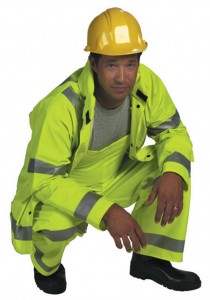Wearing a hard hat on a construction site can protect you from falling debris. Work boots, made of tough leather with steel reinforced toes, will protect your feet. You can wear special clothing to reduce your chance of injury, but what can you do to protect yourself from the most common respiratory hazards while on the jobsite?
The damage from these substances can affect your daily life—not to mention shortening your lifespan. If you’re exposed to chemical solvents, you may have symptoms like a headache, dizziness or nausea. Prolonged exposure can lead to kidney and liver damage. Solvents may affect your nervous system. Always wear your protective gear so you can keep living a healthy life.
Exposure to Synthetic Mineral Fibers
When you work with fiberglass insulation, rock wool or certain fibrous ceramic materials, you could be exposing yourself to some toxic matter that can get into your lungs and cause serious problems. Fibers can be hazardous if they come into contact with your skin or if you breathe the material into your lungs. You can develop a skin rash or irritation of the eyes, nose and throat. Lung cancer has been tied to some individuals working around fiberglass for prolonged periods of time.
To reduce the risk of any toxic side effects of working with synthetic fibers, it’s a good idea to work in a well-ventilated space. If you’re in an enclosed room, it’s helpful to have an exhaust fan. Safety should be your first concern in such an environment.
Using protective clothing to keep exposed skin to a minimum is good common sense. Goggles can keep stray fibers from landing in your eye and the proper respirator will protect you from inhaling harmful material. 
Breathing in Formaldehyde and Wood Dust Particles
Cutting, sanding and drilling both natural and treated wood products, like wood flooring and manufactured panels, can stir up a great deal of dust into the air. That dust can get suspended into the air and you can unknowingly inhale the contaminated air. While you might enjoy the smell of fresh cut pine, the sawdust can have a damaging effect on your lungs.
Even more threatening is wood and wood products that have been treated with formaldehyde. Exposure to this product that is used in glue products, wood finishes and as a wood preservative, has been shown to increase the risk of nasopharyngeal cancer and leukemia.
Having dust collection bags attached to power sanders and saws can help keep the dust under control. Workers should regularly sweep the floor and not allow big piles of sawdust to accumulate. You should always wear an approved dust mask, but you also have the right to work in a well-ventilated area. The use of a respirator may be an appropriate means of avoiding injury.
Vapors from Solvents
It’s quite common to be exposed to glues, paints, stains and other chemicals while working on a construction site. You could be varnishing a hardwood floor, painting the interior of a house or applying a protective coating to a cement floor in a warehouse and be exposed to respiratory danger the whole time. The danger comes mainly from inhaling the fumes, but the toxic elements can also be absorbed through the skin.
Common Sense
Breathing is not something we think about until it becomes labored or impossible. Just as you would struggle to avoid drowning in the ocean, construction workers should avoid hazards in the air they breath while on the jobsite. Taking precautions such as having good ventilation and wearing protective clothing and equipment, will allow you to do your job and also remain safe.

